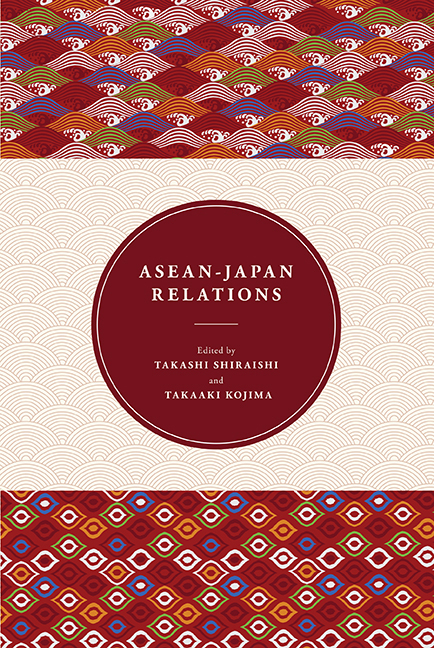Book contents
- Frontmatter
- Contents
- Preface
- About the Contributors
- 1 An Overview of Japan-ASEAN Relations
- 2 Japan's Relations with ASEAN
- 3 Approaches toward Regionalism: Japan, China and the Implications on ASEAN
- 4 The New Japan-ASEAN Partnership: Challenges in the Transformation of the Regional Context in East Asia
- 5 ASEAN-Japan Strategic Partnership and Regional Integration: Impacts and Implications
- 6 ASEAN-Japan Cooperation on Maritime Non-Traditional Security Issues: Toward a New Paradigm
- 7 Japan's Evolving Security Concerns in Maritime Southeast Asia: From Safety of Navigation to “Lake Beijing”
- 8 Evolution of Institutions and Policies for Economic Integration in East Asia: The Rise of China and Changes in the Regional Order
- 9 Managing Integration in East Asia: Behind Border Issues in Japan-ASEAN Trade Agreements
- 10 Regional Financial Cooperation in East Asia: Development and Challenges
- 11 Japanese Development Assistance to ASEAN Countries
- 12 Japanese Foreign Direct Investment in the ASEAN-4 Countries
- 13 Japan's Triple Tsunami
- 14 ASEAN-Japan Relations: A Singapore Perspective
5 - ASEAN-Japan Strategic Partnership and Regional Integration: Impacts and Implications
Published online by Cambridge University Press: 21 October 2015
- Frontmatter
- Contents
- Preface
- About the Contributors
- 1 An Overview of Japan-ASEAN Relations
- 2 Japan's Relations with ASEAN
- 3 Approaches toward Regionalism: Japan, China and the Implications on ASEAN
- 4 The New Japan-ASEAN Partnership: Challenges in the Transformation of the Regional Context in East Asia
- 5 ASEAN-Japan Strategic Partnership and Regional Integration: Impacts and Implications
- 6 ASEAN-Japan Cooperation on Maritime Non-Traditional Security Issues: Toward a New Paradigm
- 7 Japan's Evolving Security Concerns in Maritime Southeast Asia: From Safety of Navigation to “Lake Beijing”
- 8 Evolution of Institutions and Policies for Economic Integration in East Asia: The Rise of China and Changes in the Regional Order
- 9 Managing Integration in East Asia: Behind Border Issues in Japan-ASEAN Trade Agreements
- 10 Regional Financial Cooperation in East Asia: Development and Challenges
- 11 Japanese Development Assistance to ASEAN Countries
- 12 Japanese Foreign Direct Investment in the ASEAN-4 Countries
- 13 Japan's Triple Tsunami
- 14 ASEAN-Japan Relations: A Singapore Perspective
Summary
INTRODUCTION
ASEAN-Japan cooperation, through Japan's milestone doctrines that set the direction for regional cooperation, has positively affected ASEAN's efforts for regionalism, including the role of ASEAN-dominated processes like the ASEAN Regional Forum (ARF), ASEAN Plus Three (A+3), and the East Asia Summit (EAS) in enhancing cooperation. These processes contribute to addressing issues and challenges faced by ASEAN and the region, and provide new opportunities for ASEAN leadership in the 21st century. Japan's role in these processes, based on the “heart-to-heart” principles of the 1977 Fukuda Doctrine, served as a bridge, initially between the no-ncommunist ASEAN states and communist/socialist non-ASEAN mainland Southeast Asian states, and evolving gradually into constructive support for ASEAN's growth and development as the grouping's membership expanded. Japan has been most active under the A+3 framework, assisting the ASEAN countries in addressing emerging human security and development issues.
Japan has an important role in moving forward key regional processes with ASEAN. Through the ASEAN initiatives, which are complemented by sub-regional and bilateral collaboration, Japan is helping ASEAN members build national capacities to complement their regional commitments. Japan is also assisting the newer ASEAN members integrate fully into the ASEAN mainstream by sharing Japan's nation-building and development experience in areas such as economic modernization, democratization, governance, and accountability.
The recent policy statement by Prime Minister Abe on Japan's new foreign policy pillars, which focus on partnerships in the (East Asia) region for economic prosperity, provides the vision for this enhanced role in moving forward the ASEAN-Japan strategic partnership at many levels.
An important element in ASEAN-Japan relations is the integration of ASEAN's newer members, Cambodia, Myanmar, Laos, and Vietnam (collectively referred to as “CLMV”), into ASEAN. Since the 1990s, Japan has implemented focused policies and strategies to enhance the development of the CLMV to facilitate their integration into ASEAN. The Master Plan on ASEAN Connectivity provides fresh impetus to infrastructure development in the CLMV. Japan's participation in these processes takes several forms, including initiatives under the Greater Mekong Sub-region (GMS) program of the Asian Development Bank (ADB) and the Initiative for ASEAN Integration (IAI). Complementary to the IAI, the Mekong-Japan Economic and Industrial Cooperation Initiative provides another framework for Japan's partnership with the CLMV countries, to help develop the CLMV sub-region into an integrated destination for Japanese foreign direct investment (FDI).
- Type
- Chapter
- Information
- ASEAN-Japan Relations , pp. 73 - 95Publisher: ISEAS–Yusof Ishak InstitutePrint publication year: 2013

